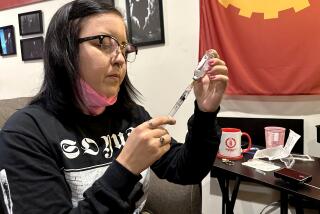A diabetes patient hurt by a do-it-yourself pancreas prompts an FDA warning
The U.S. Food and Drug Administration warned diabetics against building their own artificial pancreas system to help control blood sugar levels after a patient using one suffered an accidental insulin overdose.
A large community of diabetics has been using hacked-together, do-it-yourself systems to control their disease. The systems connect glucose monitors to insulin pumps using computer algorithms. They work around the clock, testing blood sugar and infusing insulin. Once the system is set up, they’re meant to require little effort by the patient.
While the individual components that make up a DIY system are generally approved by the FDA, they haven’t been tested or cleared for use together, the agency said in a statement. The accidental insulin overdose didn’t kill the patient, an FDA spokeswoman said.
“Patient use of unauthorized diabetes-management devices, alone or along with other devices, could result in inaccurate glucose level readings or unsafe insulin dosing,” the FDA said. “These inaccuracies may lead to injuries requiring medical intervention, such as severe low blood sugar, coma, diabetic ketoacidosis — the buildup of acids in blood — and death.”
Another downside to U.S. healthcare: Way more opportunities for fraud »
The FDA warning is an example of the tension between patients who want to take more of their healthcare into their own hands and increasingly have the technological tools and know-how to do so, and regulators charged with safeguarding public health.
The FDA received a report about a patient using one of the unauthorized systems who got too much insulin after repeated, incorrect readings of high blood sugar levels that caused an overdose and required medical intervention.
“These devices were not designed to be used together and were combined in a way that had not been thoroughly tested for compatibility,” the agency said. It’s not clear if the problem stemmed from inaccurate glucose values or a software malfunction.
The systems are informally known as an artificial pancreas, because the pancreas is the organ that produces insulin needed to convert blood sugar into energy. Patients with Type 1 diabetes, the most severe form, don’t produce any insulin naturally. Instead, they have to regularly inject it to avoid glucose buildup that eventually damages the heart and blood vessels, and causes complications including blindness, kidney failure and amputations. Too much insulin, however, can cause an overdose — leading to a coma or death.
Medtronic Plc makes an approved version of the technology, called the 670G. While closely regulating insulin levels, it doesn’t allow as much flexibility as the systems that individuals make themselves.
The FDA said that some companies had been marketing unauthorized software that shows patients glucose levels pulled from raw data. The agency didn’t identify the companies but said the software could result in inaccurate values being shown to the patient.
More to Read
Inside the business of entertainment
The Wide Shot brings you news, analysis and insights on everything from streaming wars to production — and what it all means for the future.
You may occasionally receive promotional content from the Los Angeles Times.










